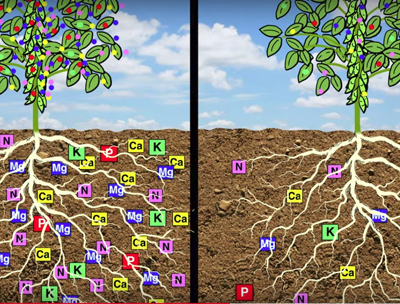5585 Guilford Road • Madison, WI 53711-5801 • 608-273-8080 • Fax 608-273-2021
www.agronomy.org
Twitter | Facebook
NEWS RELEASE
Contact: Hanna Jeske, Associate Director of Marketing and Brand Strategy, 608-268-3972, hjeske@sciencesocieties.org
How do fertilizers help with food security?
Jan. 22, 2018 - Consumption of crops is outgrowing the production of crops around the world. Malnutrition and starvation are major international issues. Fertilizers can help growers increase food production, but how? The January 22 Sustainable, Secure Food blog post explains how fertilizers help growers provide nutritious, affordable food for the world’s growing population.
 According to blogger Amanda Ramcharan, Pennsylvania State University, “Without the use of fertilizers–whether organic or inorganic–we cannot currently feed the world’s population. It is estimated that at least 30-50% of crop yields globally are attributable to fertilizer application. This makes fertilizers a key ingredient for maintaining food production to meet global population growth. Agronomists continue to develop better management practices to grow enough nutritious, affordable food while protecting the environment.”
According to blogger Amanda Ramcharan, Pennsylvania State University, “Without the use of fertilizers–whether organic or inorganic–we cannot currently feed the world’s population. It is estimated that at least 30-50% of crop yields globally are attributable to fertilizer application. This makes fertilizers a key ingredient for maintaining food production to meet global population growth. Agronomists continue to develop better management practices to grow enough nutritious, affordable food while protecting the environment.”
The blog explains the nature of different fertilizers and their use.
It’s not just about yield; it's also about the nutritional content of the food. Ramcharan uses an example of two tomatoes grown in a home garden. “Let’s say you plant two tomato plants of the same variety,” she writes. “One tomato plant goes into a robust, nutrient-rich soil in one area of your garden. In another area of your garden, you forgot to add compost last fall or didn’t add fertilizer. That soil is nutrient-deficient, but looks fine to your eyes. You plant your second tomato there. Both plants yield red, juicy tomatoes that taste the same. But the tomatoes–if tested for nutrients–would be different. The one grown in the healthy soil will have more nutrients for you to consume than one grown in a poor soil. But you cannot tell that just by looking at the tomatoes! It’s also quite likely that your garden will yield fewer tomatoes from the plant grown in nutrient-deficient soil.”
To read the complete blog, visit Sustainable, Secure Food at https://sustainable-secure-food-blog.com/2018/01/22/how-do-fertilize…th-food-security/
This blog is sponsored and written by members of the American Society of Agronomy and Crop Science Society of America. Our members are researchers and trained, certified, professionals in the areas of growing our world’s food supply while protecting our environment. We work at universities, government research facilities, and private businesses across the United States and the world.